Scottish Schools Adolescent Lifestyle and Substance Use Survey (SALSUS): mental wellbeing report 2018
Mental health and wellbeing findings from the 2018 wave of the Scottish Schools Adolescent Lifestyle and Substance Use Survey (SALSUS).
This document is part of a collection
3 Emotional and behavioural problems, mental wellbeing and equalities
This section details factors that are linked to differences in emotional and behavioural problems and mental wellbeing for adolescents. Here, we focus our analysis on the relationship between area based deprivation (using the Scottish Index of Multiple Deprivation (SIMD[12])), long-term illness or disability, caring responsibilities, emotional and behavioural problems (using the SDQ overall score) and mental wellbeing (using WEMWBS mean scores).
It should be kept in mind that using SIMD means that we are looking at an area based measure to identify deprivation in individuals. Many people who are materially disadvantaged as individuals live in areas that are not particularly deprived in terms of SIMD. Equally, many people living in deprived areas (as identified by SIMD) may not be particularly disadvantaged.
Deprivation
Emotional and behavioural problems
There was a clear link between SIMD and emotional and behavioural problems. As Figure 3.1 shows, in 2018 pupils who lived in SIMD 5[13] (the least deprived areas) were less likely to have a borderline or abnormal overall SDQ score (at 34%) than those in SIMD 1 (the most deprived areas) (at 42%).
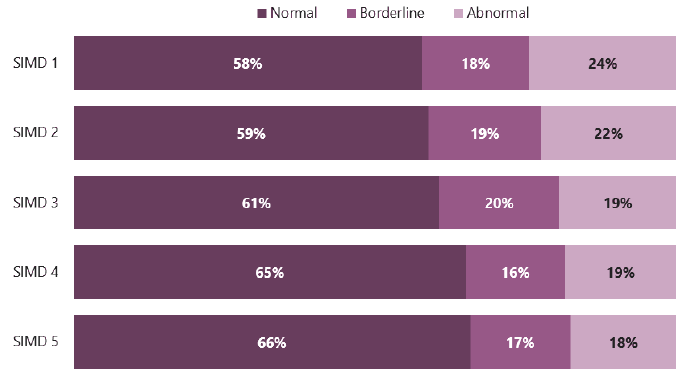
A graph showing the overall SDQ scores of pupils by Scottish Index of Multiple Deprivations (SIMD). The figure shows that for pupils who lived in SIMD 1, 58% scored in the normal range, 18% in the borderline range, and 24% in the abnormal range. For students living in SIMD 2, 59% scored in the normal range, 19% in the borderline range, and 22% in the abnormal range. For students living in SIMD 3, 61% scored in the normal range, 20% in the borderline range, and 19% in the abnormal range. For students living in SIMD 4, 65% scored in the normal range, 16% in the borderline range, and 19% in the abnormal range. For students living in SIMD 5, 66% scored in the normal range, 17% in the borderline range, and 18% in the abnormal range.
Base: See Appendix A
Mental wellbeing
With the exception of 15 year old boys, where there was very little difference in pupils' mental wellbeing across SIMD areas. WEMWBS mean scores increased (indicating better mental wellbeing) as deprivation decreased. For example, among 13 year old boys, those living in SIMD 1 (the most deprived areas) had an average WEMWBS score of 48.4, compared with an average score of 51.2 among those living in SIMD 5 (the least deprived areas) (Figure 3.2).
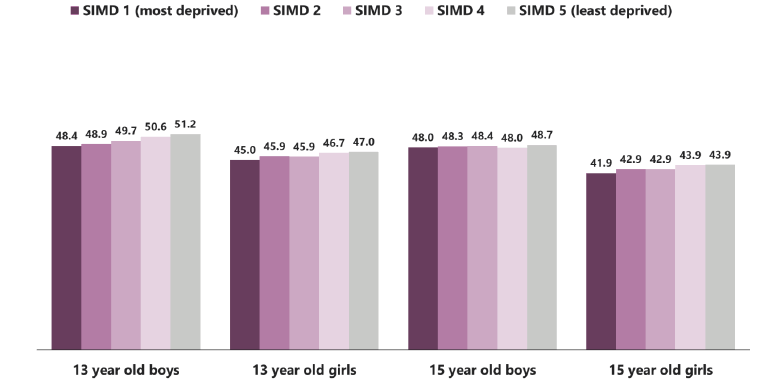
A graph showing the mean WEMWBS scores for 13 year old girls, 13 year old boys, 15 year old girls, and 15 year old boys, across the 5 SIMD areas. SIMD 1 indicated the most deprived area, and SIMD 5 indicates the least deprived area.
The figure shows that the mean score for 13 year old boys living in SIMD1 was 48.4, for those living in SIMD 2 it was 48.9, for those living in SIMD 3 it was 49.7, for those living in SIMD 4 it was 50.6, and for those living in SIMD 5 it was 51.2.
The mean score for 13 year old girls living in SIMD1 was 45, for those living in SIMD2 and SIMD3 it was 45.9, for those living in SIMD4 it was 46.7, for those living in SIMD5 it was 47.
The mean score for 15 year old boys living in SIMD1 was 48, for those living in SIMD2 it was 48.3, for those living in SIMD3 it was 48.4, for those living in SIMD4 it was 48, for those living in SIMD5 it was 48.7.
The mean score for 15 year old girls living in SIMD1 was 41.9, for those living in SIMD2 and SIMD3 it was 42.9, for those living in SIMD4 and SIMD5 it was 43.9.
Base: See Appendix A
Long term illness or disability
Emotional and behavioural problems
Pupils who reported that they had a long term illness or disability were twice as likely as those who did not to have a borderline or abnormal overall SDQ score (60% compared with 30%) (Figure 3.3.)
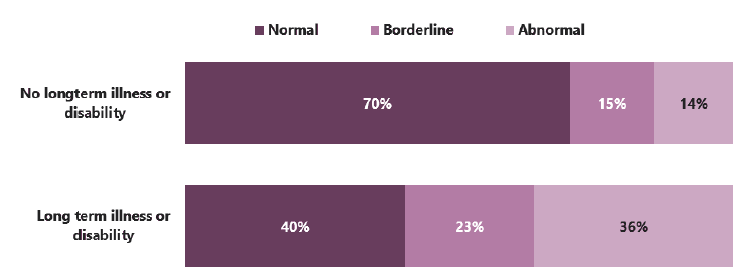
This graph shows overall SDQ scores based on whether pupils had a long term illness or disability. The figure indicates that for pupils that do not have a longterm illness or disability, 70% score within the normal range, 15% scored within the borderline range, and 14% scored within the abnormal range. The figure also indicates that for pupils with a longterm illness or disability, 40% scored within the normal range, 23% scored within the borderline range, and 36% scored within the abnormal range.
Base: See Appendix A
Mental wellbeing
Those with a long term illness or disability had lower levels of mental health and wellbeing than those who did not – this was true across both genders and age groups (Figure 3.4).
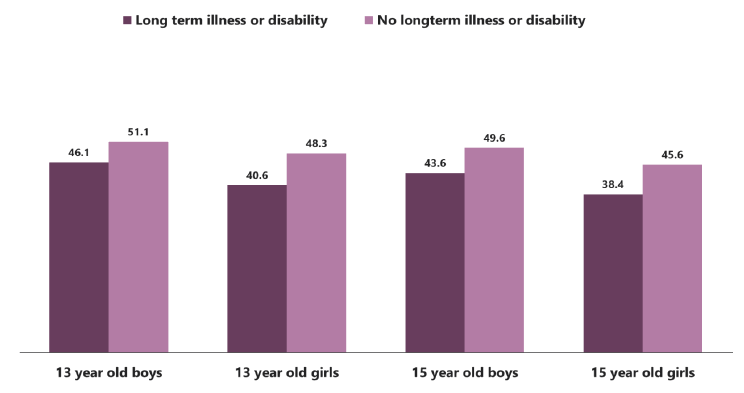
A graph showing the 2018 mean WEMWBSscores among 13 year old boys and girls, and 15 year old boys and girls based on whether pupils had a long term illness or disability.
The figure indicates that 13 year old boys with a long term illness or disability had a mean score of 46.1, and those without a longterm illness or disability had a mean score of 51.1.
The figure indicates that 13 year old girls with a long term illness or disability had a mean score of 40.6, and those without a longterm illness or disability had a mean score of 48.3.
The figure indicates that 15 year old boys with a long term illness or disability had a mean score of 43.6, and those without a longterm illness or disability had a mean score of 49.6.
The figure indicates that 15 year old girls with a long term illness or disability had a mean score of 38.4, and those without a longterm illness or disability had a mean score of 45.6.
Base: See Appendix A
Caring responsibilities
Emotional and behavioural problems
Pupils were asked: 'Do you care for or look after someone in your home because, for example, they have long-term physical/mental ill health/disability? In other words, are you a young carer?'
Eleven per cent of pupils had caring responsibilities at home. Pupils who were young carers were considerably more likely to have a borderline or abnormal overall SDQ score. 53% of pupils with caring responsibilities had a borderline or abnormal overall SDQ score compared with 35% of who did not have caring responsibilities (Figure 3.5).
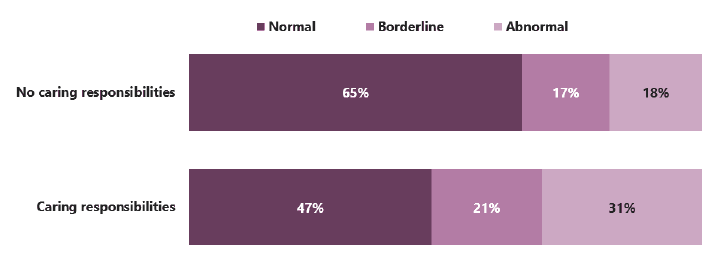
This graph shows overall SDQ scores based on whether or not pupils had caring responsibilities. The figure indicates that for pupils that do not have any caring responsibilities, 65% scored within the normal range, 17% scored within the borderline range, and 18% scored within the abnormal range. The figure also indicates that for pupils with caring responsibilities, 47% scored within the normal range, 21% scored within the borderline range, and 31% scored within the abnormal range.
Base: See Appendix A
Mental wellbeing
Pupils who had some form of caring responsibility at home were more likely to have lower mental wellbeing than those who did not (Figure 3.6), but this was much less pronounced than the association with emotional and behavioural problems.
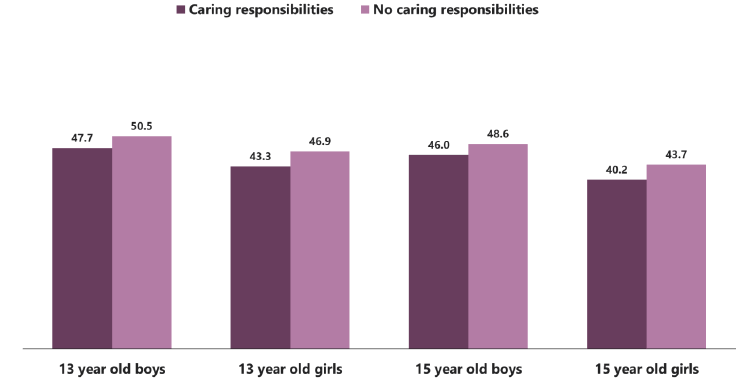
A graph showing the mean WEMWBS scores among 13 year old boys and girls, and 15 year old boys and girls based on whether pupils had caring responsibilities.
The figure indicates that 13 year old boys with caring responsibilities had a mean score of 47.7, and those with no caring responsibilities had a mean score of 50.5.
The figure indicates that 13 year old girls with caring responsibilities had a mean score of 43.3, and those with no caring responsibilities had a mean score of 46.9.
The figure indicates that 15 year old boys with caring responsibilities had a mean score of 46, and those with no caring responsibilities had a mean score of 48.6.
The figure indicates that 15 year old girls with caring responsibilities had a mean score of 40.2, and those with no caring responsibilities had a mean score of 43.7.
Base: See Appendix A
Contact
Email: salsus@gov.scot
There is a problem
Thanks for your feedback